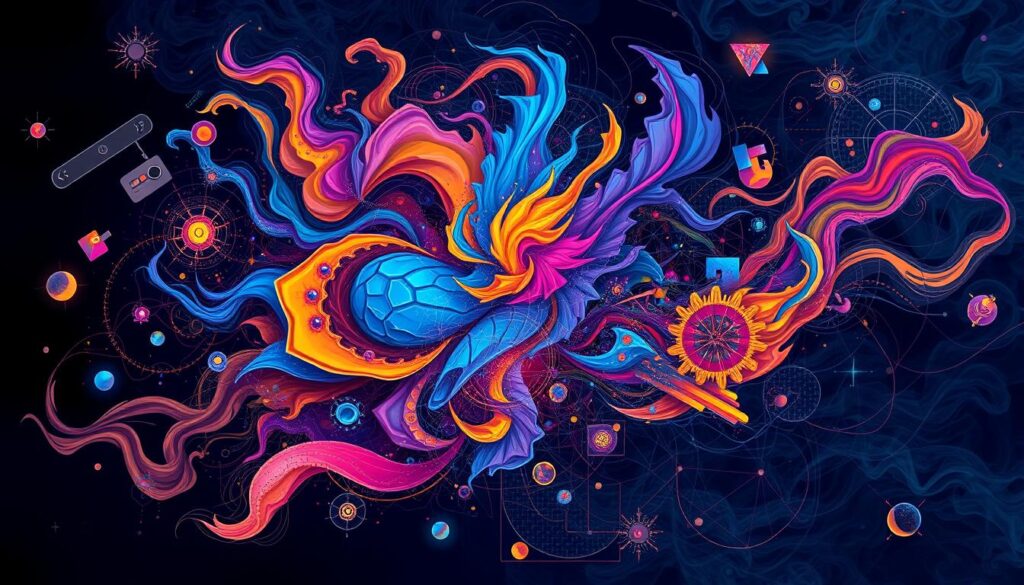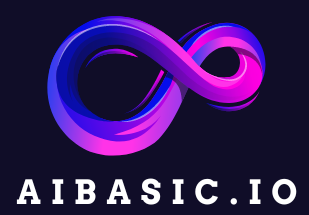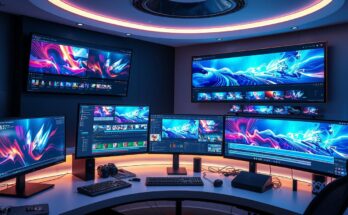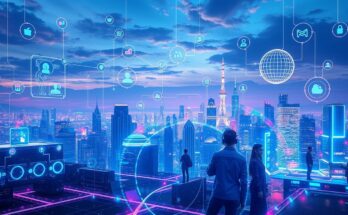Generative AI Art: Explore the intersection of AI and human creativity
Did you know OpenAI’s GPT-4 has about one trillion parameters? This has greatly changed how we think about creativity in art and tech1. Today, we see a mix of generative AI art and human creativity changing the world of art. This new mix is based on creative algorithms that change how we make and see art.
For example, AI tools like Dall-E can create complex and detailed art easily. This shows how powerful AI is in making art1. But, there are also worries. Some say AI art might make human creativity seem less real. This could lead to a time when traditional art jobs are at risk2.
This brings up big talks about originality, working together, and AI’s role in creativity. It’s seen as both a tool to help and a rival in making art.

Key Takeaways
- OpenAI’s GPT-4 represents a significant shift in creativity, with one trillion parameters.
- Generative AI art is reshaping the perception of creativity in various industries.
- Concerns exist regarding the authenticity of AI-generated art and its impact on artists.
- AI tools help streamline the creative process, allowing for more innovative thinking.
- The collaboration between AI and human creators presents both opportunities and challenges.
The Evolution of Art and Technology
Art and technology have been connected for decades. New tech often sparks new art movements. At the same time, art inspires tech innovations. This cycle has led to the creation of groundbreaking digital art.
The Impact of Historical Art Movements on Technology
Digital art started in the 1960s, marking a significant shift in art history3. Generative art, using algorithms, became popular in the 1960s and 1970s3. Harold Cohen’s AI program, AARON, was a major breakthrough in the 1980s and 1990s4.
These early developments paved the way for today’s artists to explore new mediums.
How New Media Changed Artistic Expression
AI tools have changed the art world by breaking free from traditional mediums3. This change allows artists to try new things and makes art more accessible3. Generative adversarial networks (GANs) have also changed AI art4.
These algorithms open up endless possibilities for unique visuals3. As AI becomes more common in art, it raises questions about authorship and ownership4.
Understanding Generative AI Art
Generative AI art is where tech meets creativity. It uses algorithms and machine learning to make art. This art can be visual or sound-based. It’s a new way for artists and tech experts to express themselves.
What is Generative AI?
Generative AI creates unique art using advanced machine learning models. Artists like Pindar van Arman and Gene Kogan use Generative Adversarial Networks (GANs) to make amazing images. This shows how AI can change what we think of as art5.
Tools like DALL-E and Midjourney can turn ideas into real images. This changes how we see art6. Experts have talked about how art and AI are changing together7.
How Generative AI Creates Artwork
Generative AI uses models like GANs, Variational Autoencoders (VAEs), and Diffusion models. These models look at big datasets to create art. For example, DALL-E and Stable Diffusion can make art in seconds with just a prompt6.
This mix of tech and creativity leads to new ideas. A project at MIT showed how AI can make videos into stories7.
The Role of Machine Learning in Creative Processes
Machine learning has changed how we create art in many ways. It helps artists use new methods that make their work better. This tech lets them explore more and break old rules of art.
How Algorithms Enhance Artistic Algorithms
Algorithms help artists by looking at lots of data to come up with new ideas. For example, AI can make cool patterns and change images, inspiring artists8. Musicians also use AI to make new sounds, opening up new music styles8. But, using AI too much can make artists worry about losing their own skills and voice8.
Case Studies of Successful AI Artworks
There are many examples of AI changing art for the better. Tools like DALL-E and DeepArt have changed how we make pictures9. AI music, like MuseNet, has even caught the eye of famous orchestras9. Also, a lot of money is being spent on AI, showing people believe in its power in art10.
As AI gets better, finding the right mix of human and machine creativity is key. The future of AI in art looks like a team effort, bringing new ideas and solving questions about who made it10. This teamwork could change what we think of as art and celebrate the unique things humans and machines can do.
| Aspect | Impact |
|---|---|
| Visual Art | AI creates immersive, unique compositions, enhancing artists’ creativity. |
| Music | AI composes innovative melodies that redefine musical genres. |
| Writing | AI generates prompts that support writers in overcoming creative blocks. |
| Investment Growth | Significant increases in funding indicate growing confidence in AI’s potential. |
| Challenges | Dependence on AI may lead to decreased artistic skills and authenticity. |
Generative AI Art: A New Era in Creativity
The AI creativity debate asks if AI can truly be creative or just copy humans. It makes us think deeply about originality in art and what creativity really is. As AI gets better, artists and tech experts must explore new possibilities and face challenges in expressing ourselves.
The Debate: Is AI Truly Creative?
Generative AI has made us wonder if it can be more creative than humans. This could change many jobs. Researchers say we need to understand how humans and AI can work together better11.
This shows a big change in how we see creativity. It’s not just for humans anymore. It’s something we can do with AI’s help.
Exploring the Limits of AI-Generated Art
AI can do a lot, but it has its limits. AI art often misses the emotional and story depth that humans bring. There are also worries about AI’s biases and safety12.
These issues make us think hard about what makes art original and real. They ask us to consider what creating means in a world where machines help us.

Collaborative Potential Between Humans and AI
Artificial intelligence has opened new doors for artists and technology to work together. This partnership brings together human creativity and AI’s technical skills. Artists use AI to explore new ways to create, changing how art is made.
Examples of Successful Human-AI Collaborations
In March 2024, New York hosted an exhibit called Human-Assisted Art: Gallery Party. It showed how AI can boost human creativity through interactive installations13. The Poetry Camera by Ryan Mather and Kēlín Carolyn Zhang turns scenes into poetry, showing how well humans and AI can work together13. The AI Photobooth by Nikhil Thorat and Caroline McGuire mixes old-school photography with AI, creating new images based on prompts13.
How Artists Incorporate AI Tools in Their Work
AI tools help artists improve their work, making them more productive. Studies show AI can make artists 50% more productive, and even more so in the next month14. AI-generated art is also seen as 50% more valuable after three months, proving AI’s worth in creative work14. Plus, artists using AI get better feedback from their peers, showing the power of teamwork in art14.
| Project | Creators | Highlights |
|---|---|---|
| Human-Assisted Art: Gallery Party | Various Artists and Technologists | Interactive installations enhancing creativity13. |
| Poetry Camera | Ryan Mather and Kēlín Carolyn Zhang | Generates poetry from captured scenes13. |
| AI Photobooth | Nikhil Thorat and Caroline McGuire | Combines photography with AI13. |
| Generative AI Impact | Various Artists | 50% increase in productivity for AI adopters14. |
The Future of Art in a Tech-Driven World
The role of AI in art is set to grow a lot. The AI market is expected to grow by 37.7% from 2023 to 2030. This means more technology in creative fields. Artists will mix their skills with AI’s power, creating new art forms we can’t imagine yet15.
Predictions for AI’s Role in Artistic Creation
AI tools are getting better fast. For example, Midjourney is now making human-like features better than before15. Places like Art Blocks are changing how we see and value art. They’ve helped sell over $1 billion in generative art NFTs, showing a big shift towards tech in art16.
At the MIT Bartos Theater, people talked about AI art. They discussed how mixing human creativity with AI could change art forever17.
There’s a lot of interest in AI art, with #aiart on Instagram having over 8.5 million posts. But, traditional art hashtags are still more popular. This shows both chances and challenges for AI in art. A study found that while only 27% of people had seen AI art, 56% liked it. This suggests AI art might become more accepted15.
AI is changing art and culture, like Netflix’s animated short film. It used AI for its background art15. As artists get used to these changes, they might work even more with AI. This could take art to new heights in the future.
Ethical Considerations in AI and Creativity
The fast growth of AI in art brings up big ethical questions. These include the ethics of AI in art, who owns AI-made works, and how AI changes creativity. As AI art becomes more common, there’s a big debate about who owns it. Artists, developers, and AI systems all have different views on who should own AI art.
Ownership and Copyright Issues of AI-Generated Art
There’s a big problem with owning and copying AI art. About 60% of AI art cases have disputes over who owns it18. Artists say using AI saves them 15-20% of their time, but it makes owning their art harder18. Laws are slow to catch up with AI’s fast changes, leaving many questions about who owns AI art19.
The Philosophical Implications of AI in Art
AI in art makes us think differently about art and who makes it. Some say AI’s ability to create new things makes us rethink what it means to be an artist. AI has even made art that’s 25% better than what humans can do, with new textures and colors18. But, AI can also show bias, which is unfair and needs to be fixed to make art for everyone19.
AI Art Tools: Empowering Digital Creativity
AI art tools are changing the art world. They help artists in many ways, from making images to managing their work. These tools let artists explore new ideas and create amazing things.
Popular Tools and Applications Driving AI Art Creation
Many AI art tools are now available. DALL-E can turn words into pictures, helping artists bring ideas to life20. Adobe Sensei makes tasks like color correction easier for digital painters20. Brushstroke turns photos into paintings, mixing art and photography20.
NVIDIA Canvas helps create big, detailed landscapes20. Artbreeder lets users mix images and textures, making new visuals20. RunwayML combines hand-drawn art with AI textures, boosting creativity20.
How Technology-Driven Art is Changing Industry Norms
AI is changing the art world a lot. It makes artists work with AI, creating new and exciting things21. Generative AI uses algorithms to make original art, leading to unique pieces21.
These tools are now available to everyone, not just professionals21. Artists can try new styles and ideas, making art more diverse21.

| AI Art Tool | Main Feature | Target Artist |
|---|---|---|
| DALL-E | Generates images from textual descriptions | Concept artists |
| Adobe Sensei | Streamlines color correction and selection | Digital painters |
| Brushstroke | Converts photos to paintings | Mixed media artists |
| NVIDIA Canvas | Creates expansive landscapes | Game designers, digital artists |
| Artbreeder | Blends images and textures | Experimental artists |
| RunwayML | Integrates hand-drawn art with AI textures | Artists seeking fusion |
Conclusion
Generative AI art has changed how we create art, blending tech and human creativity. Tools like ChatGPT and Midjourney make creating content fast and easy. But, there are big worries about copyright and if it lowers the value of art skills22.
The sale of “Portrait of Edmond de Belamy” for $432,500 shows AI art’s financial side23. Yet, there are big challenges too. AI art often lacks the depth and emotion that real art has23.
Legendary animator Hayao Miyazaki says AI can’t replace human creativity. He fears AI art might be too plain and lack the spark of human imagination22. As we look to the future, talking about ethics, like bias and fairness, is key.
In short, AI has the power to make art more accessible and inspire new ideas. But, we must make sure tech helps, not replaces, the human touch in art. The future of creativity is about working together, improving both AI and human art, creating a world where both are valued23.
CPMPLEMENTARY ARTICLE :https://aibasic.io/ai-tools-for-finance-boost-your-financial-game/
FAQ
What is generative AI art?
Generative AI art is made using artificial intelligence. It creates unique pieces from data inputs and training. This art can be visual, musical, and more, all made with machine learning.
How does generative AI work?
Generative AI uses machine learning, like neural networks. These networks study big datasets to learn about art. By using prompts, they make original art that mixes human creativity with machine smarts.
What distinguishes AI-generated art from traditional art?
The main difference is how it’s made. Traditional art comes from human artists’ skills and intuition. AI art, on the other hand, is made by machines using data and algorithms.
Are there ethical concerns related to AI art?
Yes, there are ethical worries. Questions include who owns AI art and if it can be as creative as human art. There’s also debate about its emotional depth.
Can AI truly be creative, or is it just mimicking human inputs?
This debate is ongoing. AI can make new combinations and forms from its training. But, some say it lacks the creativity and emotional depth of human art.
What are some popular AI art tools?
Tools like DALL-E, Midjourney, and Runway ML are popular. They help artists use AI for innovative and complex art.
How have artists integrated AI into their work?
Artists now use AI to spark new ideas and improve techniques. This has led to groundbreaking works that blend traditional and AI-driven art.
What is the future of generative AI in art?
The future of AI in art looks bright. Technology will keep evolving, changing how we create. Artists will find new ways to mix their ideas with AI’s insights, leading to new art movements.
How has technology influenced art movements historically?
Technology has always shaped art. For example, photography changed painting, and computers and the internet led to digital art. These changes have always pushed artistic boundaries.
Source Links
- Exploring the Intersection of AI and Human Creativity – https://scottdylan.com/blog/technology-and-innovation/exploring-the-intersection-of-ai-and-human-creativity/
- AI vs. Art: Navigating the Intersection of Technology and Human Creativity – https://medium.com/mr-plan-publication/ai-vs-art-navigating-the-intersection-of-technology-and-human-creativity-49c690e11fe2
- The Evolution of Digital Art: Embracing Generative AI Image Tools for Your Business | Blog | Workast – https://www.workast.com/blog/the-evolution-of-digital-art-embracing-generative-ai-image-tools-for-your/
- The history and evolution of AI-generated art – https://medium.com/higher-neurons/the-history-and-evolution-of-ai-generated-art-e5ccca5a8e83
- What is Generative Art? Algorithmic vs. AI | MakersPlace Editorial – https://rare.makersplace.com/2023/01/25/what-is-generative-art-algorithmic-vs-ai/
- How Does AI-Generated Art Work? | Built In – https://builtin.com/artificial-intelligence/how-does-AI-generated-art-work
- The Creative Future of Generative AI – Arts at MIT – https://arts.mit.edu/mit-generative-ai-art/
- Embracing Creativity: How AI Can Enhance the Creative Process – https://www.sps.nyu.edu/homepage/emerging-technologies-collaborative/blog/2023/embracing-creativity-how-ai-can-enhance-the-creative-process.html
- The Role of Generative AI in Creative Industries – Revolutionizing Art, Music, and Content Creation – https://www.linkedin.com/pulse/role-generative-ai-creative-industries-art-music-content-amit-govil-ozahf
- Artificial Imagination: The Rise of Generative AI – https://executive.berkeley.edu/thought-leadership/blog/artificial-imagination-rise-generative-ai
- Creativity in the age of generative AI: A new era of creative partnerships – https://www.sciencedaily.com/releases/2023/11/231120170939.htm
- A New Era of Creativity: How Generative AI is Reshaping Our World – https://www.linkedin.com/pulse/new-era-creativity-how-generative-ai-reshaping-our-world-cloudthat-fizde
- Artificial Intelligence versus/& Human Artists: AI as a Creative Collaborator in Art – Center for Art Law – https://itsartlaw.org/2024/04/16/artificial-intelligence-versus-human-artists-ai-as-a-creative-collaborator-in-art/
- Generative artificial intelligence, human creativity, and art – https://academic.oup.com/pnasnexus/article/3/3/pgae052/7618478
- The Future of AI Art and its Potential Interactions with the Art Industry – NHSJS – https://nhsjs.com/2023/the-future-of-ai-art-and-its-potential-interactions-with-the-art-industry/
- The Future Of Art: Generative AI, Web3 And The Immersive Internet – https://www.forbes.com/sites/bernardmarr/2023/07/28/the-future-of-art-generative-ai-web3-and-the-immersive-internet/
- The creative future of generative AI – https://news.mit.edu/2024/creative-future-generative-ai-0102
- AI and the Future of Art: Ethical Considerations for Creativity – https://medium.com/@jamesgondola/ai-and-the-future-of-art-ethical-considerations-for-creativity-84ea06fc4eff
- AI and the Future of Art: Ethical Considerations for Creativity – https://medium.com/@jamesgondola/ai-and-the-future-of-art-ethical-considerations-for-creativity-cee8bdf30cec
- Navigating the New Canvas: How Visual Artists Can Use AI to Enhance Creativity and Business – https://medium.com/@jamesdrysdale/navigating-the-new-canvas-how-visual-artists-can-use-ai-to-enhance-creativity-and-business-583378b246bc
- Generative AI Art: Unleashing Creativity in the Digital Age – https://www.solulab.com/generative-ai-art/
- The Problem With AI-Generated Art, Explained – https://www.forbes.com/sites/danidiplacido/2023/12/30/ai-generated-art-was-a-mistake-and-heres-why/
- The Future of Creativity: How Generative AI is Revolutionizing Art and Design | #art #generativeai… – https://medium.com/@rickspair/the-future-of-creativity-how-generative-ai-is-revolutionizing-art-and-design-art-generativeai-166edb1d0267




Generative AI Art: Explore the intersection of AI and human creativity – aibasic.io
thvxvkbdy http://www.g9j85f88r38bygv4b7ii18uz094ly5a8s.org/
athvxvkbdy
[url=http://www.g9j85f88r38bygv4b7ii18uz094ly5a8s.org/]uthvxvkbdy[/url]
Thank you for writing this post!